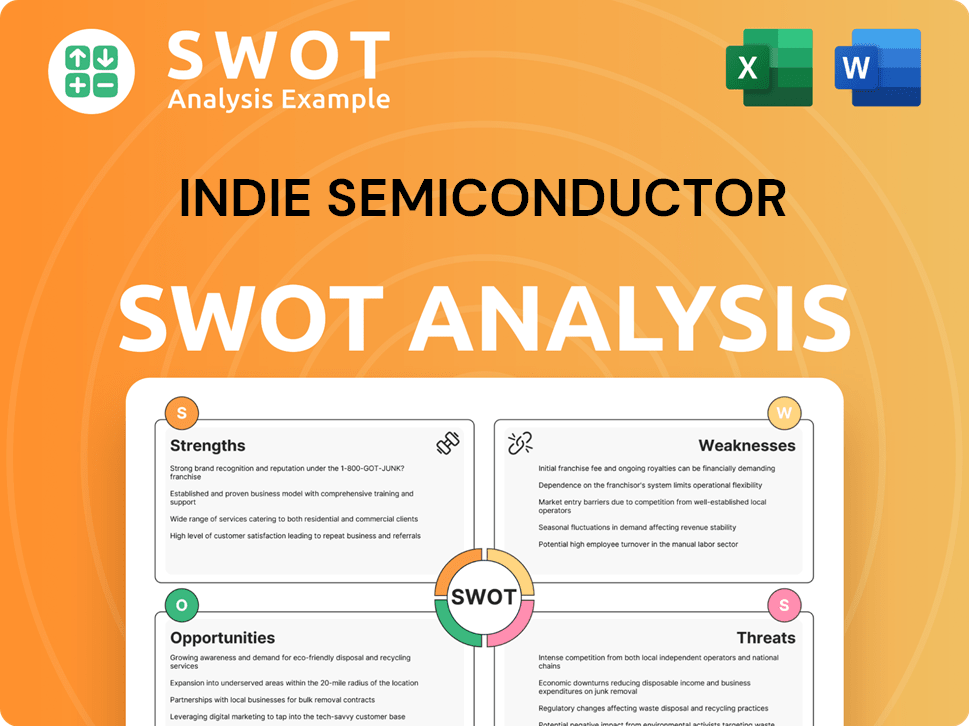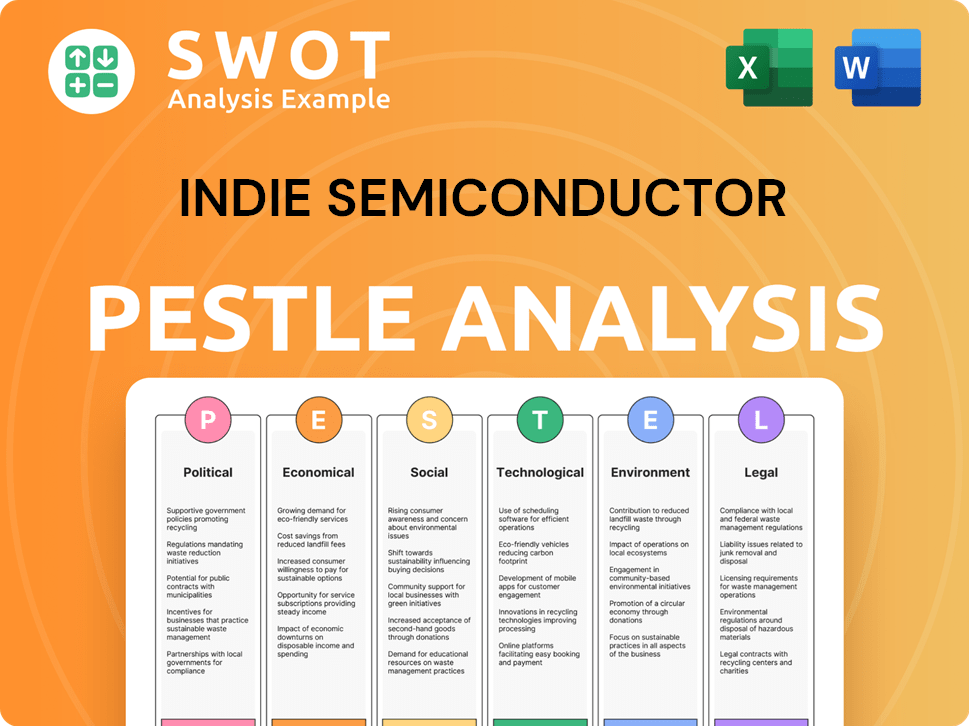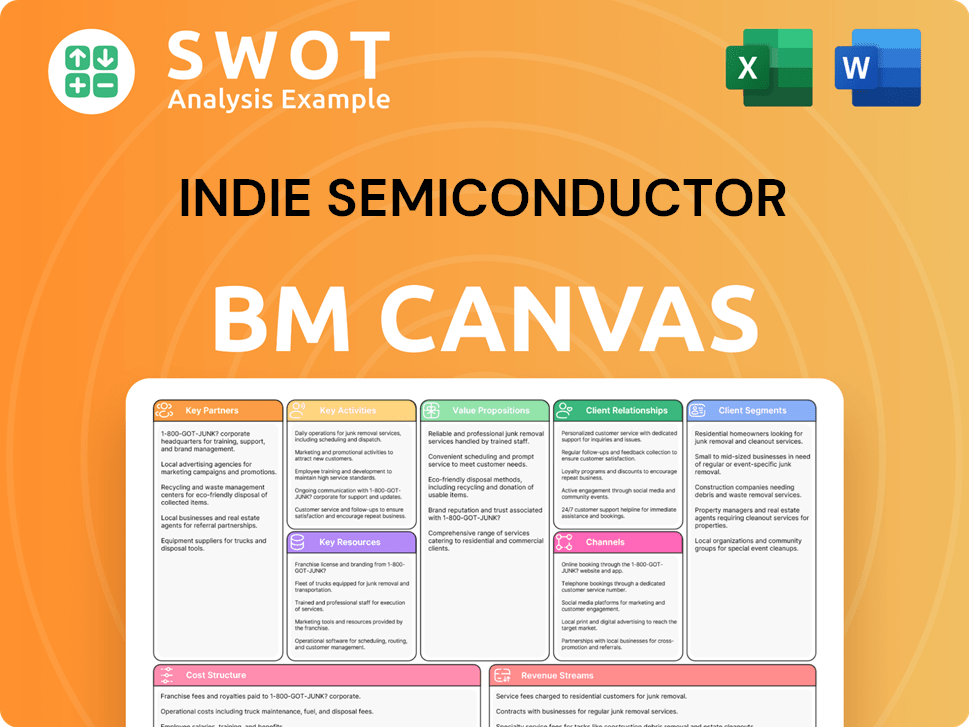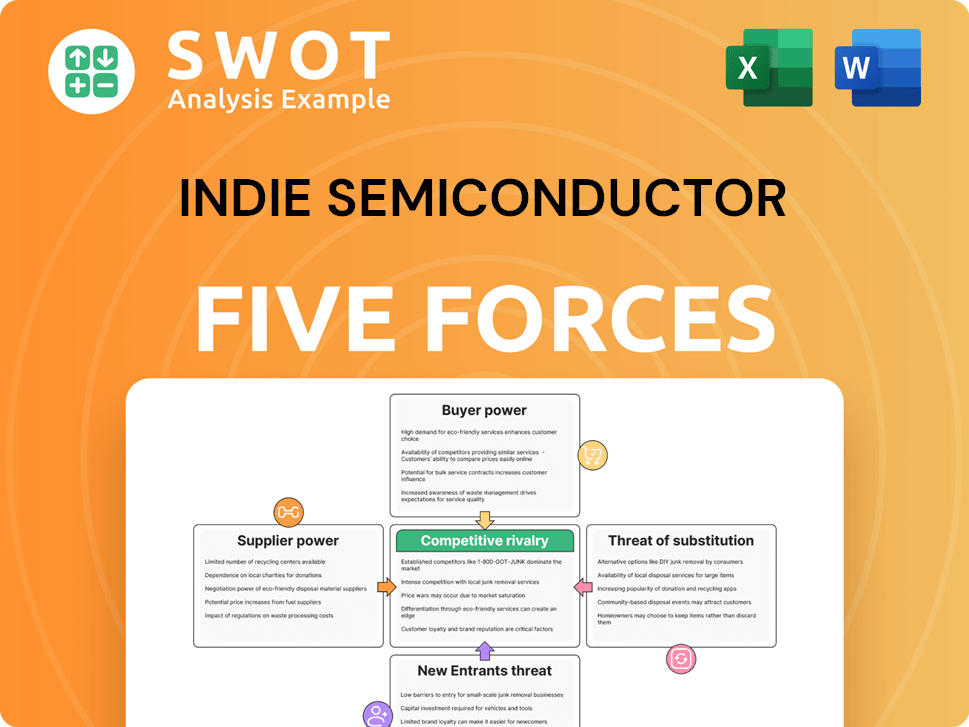indie semiconductor Bundle
Who Really Calls the Shots at indie Semiconductor?
Company ownership is a crucial element in understanding a company's strategic direction and potential. indie Semiconductor, a key player in automotive technology, has seen its ownership evolve significantly since its founding in 2007. This evolution is particularly interesting given its focus on cutting-edge technologies for the automotive industry.

Understanding the indie semiconductor SWOT Analysis is crucial to understanding the company's position. This article dives deep into the indie semiconductor ownership structure, exploring the influence of indie semiconductor investors and the impact of its transition to a publicly traded entity. We'll examine the key players, from the initial founders to the current indie semiconductor executives, to provide a comprehensive view of who owns indie semiconductor and how this shapes its future in the competitive semiconductor landscape, including its indie semiconductor stock performance.
Who Founded indie semiconductor?
The origins of indie Semiconductor trace back to its founding in 2007. The company was established by Donald McClymont, Ichiro Aoki, and Scott Kee. Understanding the initial ownership structure is key to grasping the company's early trajectory and strategic direction.
Donald McClymont currently holds the position of co-founder and chief executive officer. The early days of indie Semiconductor involved securing initial funding to support its development. The company's focus on automotive semiconductors and software solutions has been consistent since its inception.
The company operates as a Delaware corporation, serving as a holding entity for ADK LLC, a California limited liability company. This structure has been in place from the early stages of the company's development. The company's vision, centered around safer, smarter, and connected vehicles, has guided its strategic focus on ADAS and electrification.
indie Semiconductor was co-founded by Donald McClymont, Ichiro Aoki, and Scott Kee in 2007.
The company secured initial funding of $3 million early in its development.
indie Semiconductor operates as a Delaware corporation, acting as a holding company for ADK LLC.
Donald McClymont currently serves as the co-founder and CEO of the company.
The company's strategic focus has consistently been on ADAS and electrification.
The founding team's vision was to enable safer, smarter, and connected vehicles.
Understanding indie semiconductor ownership involves examining its founders, early investors, and corporate structure. The company's focus on the automotive sector, particularly ADAS and electrification, has shaped its strategic direction. The early funding of $3 million played a crucial role in the company's initial growth. For more information on their market approach, you can read about the Marketing Strategy of indie semiconductor.
- The founders, Donald McClymont, Ichiro Aoki, and Scott Kee, established the company in 2007.
- indie Semiconductor operates as a Delaware corporation with ADK LLC as its primary operating entity.
- The early vision was centered on providing semiconductors and software solutions for safer and smarter vehicles.
- The company's focus areas include ADAS and electrification, reflecting its commitment to automotive technology.
indie semiconductor SWOT Analysis
- Complete SWOT Breakdown
- Fully Customizable
- Editable in Excel & Word
- Professional Formatting
- Investor-Ready Format

How Has indie semiconductor’s Ownership Changed Over Time?
The ownership structure of indie Semiconductor, a publicly traded company, has shifted over time, reflecting its journey from its initial public offering (IPO) to its current status. As of May 2025, the ownership is primarily distributed among institutional investors, insiders, and the public. This distribution has been influenced by various factors, including market performance, strategic decisions, and investor confidence. The evolution of the ownership structure is a dynamic process, constantly adapting to market conditions and the company's strategic direction. Understanding the shifts in ownership provides insights into the company's financial health and strategic focus.
The company's ownership structure as of May 2025 shows a significant presence of institutional investors. The ownership structure has also been influenced by strategic decisions, such as the potential sale of its stake in the China-based Wuxi subsidiary. These moves aim to concentrate efforts on the global ADAS market. The company's leadership and strategic direction are significantly influenced by these major shareholders.
| Ownership Category | Percentage (May 2025) | Notes |
|---|---|---|
| Institutional Investors | Approximately 48.43% | Includes PRIMECAP Management Co., BAMCO, Inc., and Granahan Investment Management, LLC. |
| Insiders | Approximately 7.66% | Includes company executives and board members. |
| Public Companies and Individual Investors | Approximately 43.91% | Represents the remaining shares held by the public. |
Key institutional investors play a significant role in shaping the company's trajectory. As of May 2025, the major institutional shareholders include PRIMECAP Management Co., holding 15.57% (28,623,386 shares), BAMCO, Inc. with 11.14% (20,481,379 shares), and Granahan Investment Management, LLC with 9.529% (17,520,397 shares). Other significant holders include BlackRock, Inc., Vanguard Group Inc., Neuberger Berman Group LLC, and State Street Corp. These investors' decisions and strategies directly impact the company's direction and performance. For more insights, consider reading about the Growth Strategy of indie semiconductor.
The ownership of indie Semiconductor is largely influenced by institutional investors, who hold a significant portion of the company's stock.
- PRIMECAP Management Co., BAMCO, Inc., and Granahan Investment Management, LLC are among the major institutional shareholders.
- Insider ownership represents a smaller but still significant percentage of the total shares.
- Understanding the ownership structure provides insights into the company's strategic direction and financial health.
- The company's focus on ADAS solutions continues to be a key area of development.
indie semiconductor PESTLE Analysis
- Covers All 6 PESTLE Categories
- No Research Needed – Save Hours of Work
- Built by Experts, Trusted by Consultants
- Instant Download, Ready to Use
- 100% Editable, Fully Customizable

Who Sits on indie semiconductor’s Board?
The current board of directors at indie Semiconductor oversees the company's operations and strategic direction. While specific details on each member's background and representation aren't fully available, Donald McClymont, a co-founder, holds the position of chief executive officer. Understanding the composition of the board is crucial for anyone interested in indie Semiconductor's target market and overall company strategy.
The board's role is pivotal in guiding the company, especially regarding significant decisions. The board's actions, such as approving the Offer and Consent Solicitation related to warrants, demonstrate its influence on financial matters. The board's authority also extends to managing the company's capital stock, highlighting its importance in shaping indie Semiconductor's financial future.
| Board Member | Title | Notes |
|---|---|---|
| Donald McClymont | Chief Executive Officer | Co-founder |
| Information Not Available | Board Member | Details on other members are not fully detailed in the provided information. |
| Information Not Available | Board Member | Details on other members are not fully detailed in the provided information. |
The voting structure at indie Semiconductor is straightforward. Both Class A and Class V common stock generally have one vote per share. As of December 31, 2023, there were 18,694,332 shares of Class V common stock outstanding. This structure means that shareholders have a direct influence on company decisions, with both classes of stock typically voting together. The absence of cumulative voting rights for director elections further clarifies the voting process.
Understanding the board of directors and the voting structure is essential for assessing indie Semiconductor. The CEO, Donald McClymont, is a key figure. The one-share-one-vote system provides clarity for investors.
- The board of directors makes key decisions.
- Class A and Class V common stock have equal voting rights.
- As of December 31, 2023, there were 18,694,332 shares of Class V common stock outstanding.
- No cumulative voting rights exist for director elections.
indie semiconductor Business Model Canvas
- Complete 9-Block Business Model Canvas
- Effortlessly Communicate Your Business Strategy
- Investor-Ready BMC Format
- 100% Editable and Customizable
- Clear and Structured Layout

What Recent Changes Have Shaped indie semiconductor’s Ownership Landscape?
Over the past few years, the ownership profile of indie Semiconductor has seen considerable shifts. In May 2025, the company entered a non-binding agreement to potentially sell its 34.38% stake in Wuxi indie Microelectronics Technology Co., Ltd., a Chinese entity, through its subsidiary Ay Dee Kay LLC. This strategic move is designed to focus efforts on the global Advanced Driver-Assistance Systems (ADAS) market. This decision impacts the overall indie semiconductor ownership structure.
Institutional investors have shown dynamic activity in indie semiconductor stock. In Q4 2024, there was a notable increase in positions by 118 institutional investors, while 79 decreased their holdings. Significant additions during Q4 2024 included FRONTIER CAPITAL MANAGEMENT CO LLC, NEUBERGER BERMAN GROUP LLC, and BAMCO INC /NY/. Conversely, SOROS FUND MANAGEMENT LLC divested all its shares. As of January 24, 2025, total institutional ownership increased by 18.05% over the preceding three months to 232,156,000 shares. However, institutional holdings decreased by 1.1518% as of May 2025, indicating ongoing adjustments among indie semiconductor investors.
| Metric | Q4 2024 | Q1 2025 |
|---|---|---|
| Institutional Investors Increasing Positions | 118 | N/A |
| Institutional Investors Decreasing Positions | 79 | N/A |
| Total Institutional Shares (Jan 24, 2025) | N/A | 232,156,000 |
| Institutional Holdings Decrease (May 2025) | N/A | 1.1518% |
The company is also implementing restructuring measures expected to conclude by the end of the year. These efforts aim to reduce annualized operational expenses by up to $40 million, accelerating the path to profitability. Management anticipates a return to strong growth in 2025 and beyond, supported by a strategic backlog of $7.1 billion, which is projected to drive revenue growth exceeding 40%, potentially reaching breakeven without additional capital in 2025. Despite these positive projections, analysts have adjusted 2025 revenue expectations to $228.3 million, influencing the consensus price target for indie semiconductor.
The company is focusing on the ADAS market.
Institutional investors have shown dynamic activity in the stock.
Restructuring aims to cut costs and improve profitability.
Revenue expectations and price targets have been adjusted.
indie semiconductor Porter's Five Forces Analysis
- Covers All 5 Competitive Forces in Detail
- Structured for Consultants, Students, and Founders
- 100% Editable in Microsoft Word & Excel
- Instant Digital Download – Use Immediately
- Compatible with Mac & PC – Fully Unlocked

Related Blogs
- What are Mission Vision & Core Values of indie semiconductor Company?
- What is Competitive Landscape of indie semiconductor Company?
- What is Growth Strategy and Future Prospects of indie semiconductor Company?
- How Does indie semiconductor Company Work?
- What is Sales and Marketing Strategy of indie semiconductor Company?
- What is Brief History of indie semiconductor Company?
- What is Customer Demographics and Target Market of indie semiconductor Company?
Disclaimer
All information, articles, and product details provided on this website are for general informational and educational purposes only. We do not claim any ownership over, nor do we intend to infringe upon, any trademarks, copyrights, logos, brand names, or other intellectual property mentioned or depicted on this site. Such intellectual property remains the property of its respective owners, and any references here are made solely for identification or informational purposes, without implying any affiliation, endorsement, or partnership.
We make no representations or warranties, express or implied, regarding the accuracy, completeness, or suitability of any content or products presented. Nothing on this website should be construed as legal, tax, investment, financial, medical, or other professional advice. In addition, no part of this site—including articles or product references—constitutes a solicitation, recommendation, endorsement, advertisement, or offer to buy or sell any securities, franchises, or other financial instruments, particularly in jurisdictions where such activity would be unlawful.
All content is of a general nature and may not address the specific circumstances of any individual or entity. It is not a substitute for professional advice or services. Any actions you take based on the information provided here are strictly at your own risk. You accept full responsibility for any decisions or outcomes arising from your use of this website and agree to release us from any liability in connection with your use of, or reliance upon, the content or products found herein.